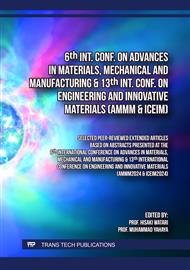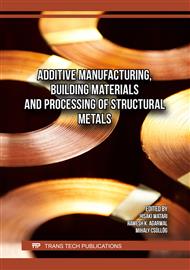p.3
p.9
p.15
p.23
p.31
p.37
p.53
p.61
Effect of Cold Rolling and Annealing on Grain Refinement of β-Type Ti-13Nb-1.5Ta-3Mo Titanium Alloy
Abstract:
The Ti-13Nb-1.5Mo-3Ta alloy is a recently developed biocompatible metastable β-Ti alloy designed for biomedical application. In this present work, the influence of cold rolling and subsequent annealing heat treatment on grain refinement of Ti-13Nb-1.5Mo-3Ta alloy was investigated. The alloy was cold rolled (CR) to 60% and 90% thickness reductions at room temperature followed by recrystallization annealing at different temperature (800°C-900°C) and time (1.5mins-10mins) before ice-water quenching. X-ray diffraction (XRD) and optical microscopy (OM) were used to characterize the alloy, and microhardness tests were carried out using the Vickers microhardness tester. The results revealed that the annealed alloys exhibited a fully β-phase, while those subjected to cold rolling displayed introduction of stress induced martensite (SIM) α′′-phase along with β-phase. The microhardness of the 60% and 90%CR samples increased significantly to 253 and 283 Vickers hardness (HV), respectively, from an initial value of 198 HV. Annealed samples exhibited a recrystallized microstructure containing fine equiaxed grains with average size of 10-50μm for 60%CR and 8-34μm for 90%CR. The grain refinement mechanisms are probably attributed to the reversal of the SIM α′′-phase back to the more stable β-phase and the recrystallization of the deformed β-phase.
Info:
Periodical:
Pages:
3-8
Citation:
Online since:
June 2025
Price:
Сopyright:
© 2025 Trans Tech Publications Ltd. All Rights Reserved
Share:
Citation:



